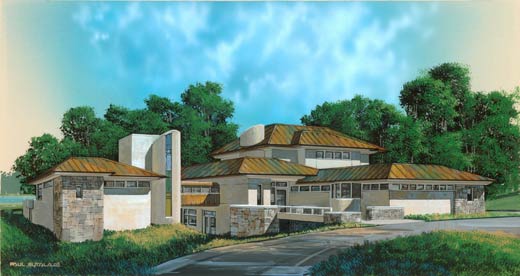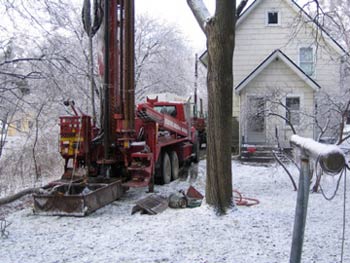 Easy Steps to Saving Hundreds on Your Energy Billsby Kelly and Matthew Grocoff
Easy Steps to Saving Hundreds on Your Energy Billsby Kelly and Matthew Grocoff
Part 2 of 3 articles (to read Part I visit our blog at GreenovationTV.com)
Originally published by the Sierra Club Huron Valley Group
(Photo of the Grocoffs by Cybelle Codish)
Green home renovations are not just a passing phase. According to the USGBC, our homes use 21% of the energy consumed in the U.S., and home energy costs have skyrocketed to an average of $3800 per year. In the near future, all homes will be built green. But, the average age of an American home is now over 30 years. That's a lot of room for energy efficiency improvements. Every year that energy prices rise, and they certainly will, investments in efficiency get better and better. Greenovations are simply the best way to future-proof your home and make it more comfortable and affordable today.
When renovating our 107-year-old home on Ann Arbor's historic Old West Side, we divided our process into four parts: 1.
Energy (reduction & production) 2.
Water efficiency 3.
Materials and resources, and 4.
Indoor environmental quality. These are not separate categories, but rather integrated parts of the whole which must be considered together. For the biggest bang for the carbon buck, we begin with energy efficiency. Later, in Part 3 of this series, we'll discuss water, materials and indoor environment.
Green Bling vs. Reduce then ProduceWhen considering cost-saving (and human species-saving) energy efficiency improvements, most of us immediately begin thinking about the shiniest, newest, most visible things that everyone is talking about - the "green bling": solar panels, wind turbines, and a Prius in the driveway. While these are all simple and available technologies that must be adopted as soon as possible, reducing the energy load is much more affordable and is an essential first step.
Reduce then produce. Any target of net-zero energy use from the grid must begin by reducing your load. As has been said many times, "efficiency is the cheapest power plant in the world." Once we reduce our load as much as possible, then we can look for sustainable renewable resources to produce what is needed for the remaining load.
If it Ain't Tight, it Ain't RightBefore considering the green bling and that new geothermal or solar thermal system, we knew we had to tighten up the house. By taking the following steps to reduce your load, it will make your home immediately more comfortable, lower your energy costs (no matter what system you currently have) and will make it less expensive for you when it comes time to bring in the bling. Step 1: Consider an Energy Audit, Step 2: Find and seal air leaks, Step 3: Insulate, Step 4: Consider sealing and improving old windows (not necessarily buying new).
 Energy Audit
Energy AuditUsing sophisticated technologies like infrared cameras or blower door pressure tests, a professional energy auditor can help you find where your house is performing poorly and recommend affordable changes. The reasonable fee they charge will pay for itself quickly if you follow their recommendations.
You can also try an easy do-it-yourself air leak test. On a very cold day, we took a lighted incense stick and waved it close to our doors, basement joists, windows and upstairs ceiling fixtures. We could see the air changes in the blowing pattern of the smoke. The bigger the gap, the more the smoke moved. These were all air leaks that we needed to fix.
This little trick will only tell you about air gaps. It won't tell you how well your home's walls and attic are insulated. For us it was easy, our attic was insulated with one layer of newspaper from 1902. We didn't need an infrared test to know that there was room for improvement. (Click here to
learn more about home energy audits)
Are You Leaving A Window Open All Winter Long? - Detecting Air Leaks
Up to 30% - 50% of home energy costs come from heat loss! Tiny gaps around things like your windows, doors, vents, and light fixtures are the single biggest cause of home heating and cooling loss. All those tiny cracks and gaps can add up to 10 sq ft or more. That's like leaving a window or door wide open all winter long!
Depending on the size and location of the gap, you can use caulk or a foam sealant such as Great Stuff (go to greatstuff.dow.com for great interactive help on sealing your home). Before insulating our attic with blown cellulose, we hunted around for every possible air gap around the chimney, light fixtures that opened to the attic, wall seams, etc and sealed them tight with spray foam. If you insulate your attic with spray foam insulation, rather than cellulose, this step is not necessary.
Next we tightened up the windows by caulking around the frames and by using rope caulk ($5.77 at Lowes) to seal gaps in between the double hung windows. The rope caulk can be easily removed and is reusable. This is a temporary solution, but it works like a charm. Further, adding exterior storm windows can be nearly as effective as replacing older windows with new ones.
And of course, we made sure we had new weatherstripping around all of the doors to prevent that blast of air that finds its way under the doors.
For even deeper efficiency, we made sure our geothermal contractor followed Code and sealed and insulated all of our ducts. According to Energy Star, sealing and insulating ducts can improve the efficiency of your heating and cooling system by 20 percent — and sometimes much more! (Click here for more about
air sealing and insulating your home)
A Warm Cozy Blanket for Your HouseNow that we've zipped up our jacket, we're ready for a warm blanket to wrap around the house. There are great benefits to both blown cellulose and spray foam insulation. Your wall type, current insulation type and your budget will all be considerations when choosing insulation. In our attic and walls we went with blown cellulose, made from recycled newspaper. Farmer's Insulation was able to cleanly remove some of the original wood siding and blow the insulation from the outside of the house, without damaging the historical integrity of the siding.
Basement joists are among the worst offenders for heat and air loss. We chose Arbor Insulation to fill all of the cavities between the foundation and the first floor with open-cell spray foam. This provided both an excellent air seal for all those nasty gaps, as well as a significant thermal barrier to hold the heat in the basement. Be sure to avoid using any foam insulation that contains ureaformaldehyde or cellulose insulation that uses aluminum or ammonium sulfate instead of boric acid as a fire retardant.
 Lights Are On . . . But Nobody's Home
Lights Are On . . . But Nobody's HomeLighting accounts for 12% of home energy consumption. As much as 60% of lighting cost are for lighting empty rooms. So, first we replaced all the lights with compact fluorescent bulbs. This gives us a huge savings each year in electricity and long term savings for having to change the bulb only every 5 years.
Next, we installed
Wattstopper motion sensor light switches throughout the house. These turn lights off automatically when the room is empty. Wattstoppers cost a bit more, but pay for themselves in a short time. (Note: ordinary light switches have a pay back time of
never).
Digging Deep for Energy Efficiency - Bring in the Bling!Heating and cooling can burn half of your energy dollars each year. When we moved into our folk-Victorian, the circa-1957 Mueller Climatrol gas furnace operated at about 40% efficiency. For every energy dollar we paid to the utility company, 60 cents went out the chimney and only 40 cents went to heat the house.

We carefully did the math on options like solar thermal heating, photovoltaic panels (solar electric), solar domestic hot water and other high efficiency heating and cooling systems. The hands down winner for us was
geothermal. For every $1 we spend on electricity to run the geothermal, we get $4 worth of heat in the house - making our system 400% efficient. The U.S. Environmental Protection Agency calls geothermal "the most energy-efficient, environmentally friendly heating and cooling technology available." It provides heating, cooling and hot water all in one hyper-efficient system.
The Cost: We can hear you asking "but isn't it really expensive?" We believe that it is more expensive not to install geothermal - both to your pocket book and the environment. Our annual heating, cooling and hot water bill is projected to be only $523! Yes, our geothermal system cost several thousand dollars more in initial costs compared to far less efficient Energy Star heater, air conditioner and hot water heater. But, by working the cost of our geothermal into our mortgage when we purchased the home, the additional capital cost is only $45 per month.
The Savings: We're proud to report that we had an immediate positive cash flow when we turned on the system last year. In February 2007, prior to installing geothermal, our heating bill was $340. In February 2008, our bill was only $100.
Now that we've reduced our energy consumption by more than half, we are exploring the options for producing our remaining energy with renewable resources such as solar electric and even small vertical wind turbines. Someday, we hope to see municipal wind farms operating across the country and every roof producing some of its own energy. In the meantime, let's all do what we can to tighten our homes as best we can. And don't forget to turn out the lights.
Links to green stuff to help greenovate your home




































